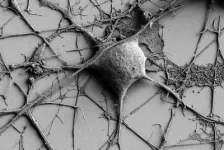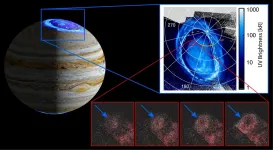Differences in herpes virus symptoms may relate to variations in strain gene expression
2021-03-29
(Press-News.org) UNIVERSITY PARK, Pa. -- Why do some people with cold sores around their lips experience painful lesions, while others have no symptoms at all, yet still spread the virus? A new study conducted at Penn State finds that these differences could be due to variations in the way certain strains of herpes simplex (HSV-1) -- the virus that causes cold sores, as well as genital herpes -- activate gene expression in neurons.
"HSV-1 occurs in more than half the global population," said Moriah Szpara, associate professor of biology and biochemistry and molecular biology. "Not only does it cause recurrent problems, such as cold sores and genital herpes, but recent research has implicated chronic HSV-1 infection with the development of disease later in life, including neurodegenerative diseases like Alzheimer's."
Szpara explained that the HSV-1 lifecycle begins upon contact with mucosal surfaces, where it invades skin cells, replicates, and can induce local lesion formation. The virus also enters local nerve endings in the skin, and transits into neurons in the nervous system. There the virus can lie dormant until it reactivates on future occasions. Neuronal damage and host immune responses triggered by viral reactivations are thought to contribute to long-term neurodegeneration.
"Since every person carries a subtly different version of HSV-1, this might explain some of the variation in human responses to infection; for example, why people have different triggers for their outbreaks or why some people experience more painful sores. Differences in the frequency of viral outbreaks, or in virus-induced gene expression patterns, might also affect the different rates at which people with chronic infections go on to develop neurodegenerative diseases."
To investigate the causes of this variation in responses, Szpara and her colleagues infected human neuronal cells with one of three HSV-1 strains that are known to differ in their ability to cause disease in the nervous system. Next, they used deep sequencing to identify and quantify the transcriptomes -- the entire set of messenger RNAs (mRNAs) made in a cell at any given time -- of the neurons during infection by HSV-1.
According to Szpara, when a neuronal cell is infected with HSV-1, the resulting transcriptome includes the whole collection of mRNAs produced by both the human neuron and the HSV-1 virus. By looking at the timing and amount of mRNAs expressed during infection, scientists can gain insights on the proteins that will soon be produced from those mRNAs. It is the viral proteins and new viral progeny produced during infection that ultimately lead to health problems.
"By simultaneously examining both the viral and neuronal transcriptomes in the infected cells we were able to observe the interplay between the timing of viral mRNA production and protein production, and the ensuing host responses," said Szpara.
The scientists used two additional techniques -- immunofluorescence staining of neurons and Western blotting for viral protein levels -- to observe the outcomes of viral and host gene expression. They also used scanning electron microscopy to directly observe changes in neuronal morphology during infection.
Their findings appeared online in PLOS Pathogens on March 22.
The researchers found that different genetic variants of HSV-1 induce different patterns of gene expression in human neuronal cells. Specifically, they found that the viral variants expressed their genes at different rates and quantities, which likely contributes to the different timing and severity of symptoms within hosts. For example, they discovered that one of the variants, which exhibits lower virulence in animal models, displays a different and seemingly delayed pace of viral and host gene expression in neurons. In another example, they found that one variant caused greater changes in expression of genes involved in cell adhesion (or ability of cells to attach to each other), which could impact cell-to-cell spread of HSV-1.
The team also found that these different patterns of gene expression were dependent on the whether the infected cell was a neuron or a skin cell type.
"Together, these data demonstrate the importance of studying virus strain- and cell-type-specific factors that may contribute to neurovirulence in vivo. It also highlights the specificity of HSV-1-host interactions," said Szpara. "Our study suggests that differences observed between viral variants in cell-based models like neurons can be used to help understand the more-complex interactions of viruses with hosts."
INFORMATION:
Other authors on the paper include Colleen Mangold, postdoctoral scholar in entomology; Molly Rathbun, graduate student in biochemistry and molecular biology; Daniel Renner, computational scientist in the Huck Institutes of the Life Sciences; and Chad Kuny, assistant research professor of biology.
This research was supported by Penn State, the Pennsylvania Department of Health, the American Heart Association and the National Institutes of Health.
[Attachments] See images for this press release:

ELSE PRESS RELEASES FROM THIS DATE:
2021-03-29
Transition metal perovskites oxides exhibit several desirable properties, including high-temperature superconductivity and electrocatalysis. Now, scientists at Tokyo Institute of Technology explore the structure and properties of a perovskite oxide, PbFeO3, in anticipation of the unusual charge distribution and exotic magnetic transitions displayed by such systems. They report two of the magnetic transitions, with a distinctive transition above room temperature and look into its causes, opening doors to potential applications in realizing new spintronic devices.
The advent of electronics has revolutionized our lives to an extent where it is impossible to imagine going about our day without relying on an electronic device in some form. What is even more remarkable, ...
2021-03-29
In a new publication from Cardiovascular Innovations and Applications; DOI https://doi.org/10.15212/CVIA.2021.0008, Zeyi Cheng, Miaomiao Qi, Chengyuan Zhang and Yanxia Mao from Sichuan University, Sichuan, China, Second Hospital of Lanzhou University, Lanzhou, China and The Second Medical School of Lanzhou University, Lanzhou, China consider myocardial fibrosis in the pathogenesis, diagnosis, and treatment of hypertrophic cardiomyopathy.
The authors review the application of myocardial fibrosis in the diagnosis and treatment of HCM, focusing on research progress and the application ...
2021-03-29
In a new publication from Cardiovascular Innovations and Applications; DOI https://doi.org/10.15212/CVIA.2021.0007, Sharen Lee and Gary Tse from Laboratory of Cardiovascular Physiology, Hong Kong, HKG, China, Second Hospital of Tianjin Medical University, Tianjin, China and Xiamen Cardiovascular Hospital, Xiamen, China consider a case of atezolizumab-induced autoimmune diabetes mellitus presenting with diabetic ketoacidosis.
Atezolizumab, an immune checkpoint inhibitor, is a humanized monoclonal, anti-programmed death ligand 1 (PD-L1) antibody used for the treatment of metastatic urothelial carcinoma that has progressed after chemotherapy. PD-L1 inhibitors can induce type 1 diabetes, and patients can present with diabetic ketoacidosis. ...
2021-03-29
In a new publication from Cardiovascular Innovations and Applications; DOI https://doi.org/10.15212/CVIA.2021.0006, Li Jingxiu, Zhang Fujun, Wei Xijin and Peng Ding from Anhui Provincial Hospital, Hefei, China, Chizhou Second People's Hospital, Chizhou, China, The Affiliated Hospital of Shandong University of TCM, Jinan, China and The Sixth Affiliated Hospital of Guangzhou Medical University, Qingyuan, China consider using three-dimensional Lorenz Scatter Plots to detect patients with atrioventricular node double path caused by interpolated ventricular premature systoles.
A series of related electrophysiology ...
2021-03-29
In a new publication from Cardiovascular Innovations and Applications; DOI https://doi.org/10.15212/CVIA.2021.0005, Nikhil H. Shah, Steven J. Ross, Steve A. Noutong Njapo, Justin Merritt, Andrew Kolarich, Michael Kaufmann, William M. Miles, David E. Winchester, Thomas A. Burkart, and Matthew McKillop from UF Division of Cardiovascular Medicine, Gainesville, FL, USA, UVA Division of Cardiovascular Medicine, Charlottesville, VA, USA, The Johns Hopkins Hospital Department of Radiology, Baltimore, MD, USA, The Heart Center, Huntsville, AL, USA, Intermountain Medical Center, St. George, UT, USA and Carolina Cardiology Consultants, Greenville, SC, USA consider appropriate use of implantable ...
2021-03-29
In a new publication from Cardiovascular Innovations and Applications; DOI https://doi.org/10.15212/CVIA.2021.0001, Zesen Han, Lihong Lai, Zhaokun Pu and Lan Yang from The People's Hospital of Hua County, Henan, China and Henan University of Science and Technology, Henan, China consider the use of nomograms to predict patients with obstructive coronary artery disease.
The authors developed and validated clinical prediction models for the development of a nomogram to estimate the probability of patients having coronary artery disease (CAD).
An individualized clinical prediction model for patients with CAD allowed an accurate estimation in Chinese populations. The Akaike information criterion is a better method in screening risk factors. The ...
2021-03-29
In a new publication from Cardiovascular Innovations and Applications; DOI https://doi.org/10.15212/CVIA.2021.0002, Pei Huang, Yi Zhang, Yi Tang, Qinghua Fu, Zhaofen Zheng, Xiaoyan Yang, Yingli Yu from The First Affiliated Hospital of Hunan Normal University) Chang Sha, China and Tianjin University of Traditional Chinese Medicine, Tianjin, China consider the study of the left atrial function index in cardiovascular disease.
Some studies have shown that left ventricular structure and function play an important role in the risk stratification and prognosis of cardiovascular disease. The clinical application of left atrial function in cardiovascular disease has gradually attracted attention in the cardiovascular field.
There are ...
2021-03-29
Hail severity will increase in most regions of the world while Australia and Europe are expected to experience more hailstorms as a result of climate change, an international review led by a UNSW Sydney researcher has found.
The review study, published in Nature Reviews Earth & Environment, examined the effects climate change will have on hail in the future.
It shows a global summary of hail trends from past observations and projected future trends from simulations and models.
The review led to the general expectation that hailstorm frequency will decrease in East Asia and ...
2021-03-29
A study led by scientists at Hong Kong Baptist University (HKBU) has decoded the genomes of the deep-sea clam (Archivesica marissinica) and the chemoautotrophic bacteria (Candidatus Vesicomyosocius marissinica) that live in its gill epithelium cells. Through analysis of their genomic structures and profiling of their gene expression patterns, the research team revealed that symbiosis between the two partners enables the clams to thrive in extreme deep-sea environments.
The research findings have been published in the academic journal Molecular Biology and Evolution.
Due to the general lack of photosynthesis-derived organic matter, the deep-sea was once considered a ...
2021-03-29
SAN ANTONIO -- March 29, 2021 -- The SwRI-led Ultraviolet Spectrograph (UVS) orbiting Jupiter aboard NASA's Juno spacecraft has detected new faint aurora features, characterized by ring-like emissions, which expand rapidly over time. SwRI scientists determined that charged particles coming from the edge of Jupiter's massive magnetosphere triggered these auroral emissions.
"We think these newly discovered faint ultraviolet features originate millions of miles away from Jupiter, near the Jovian magnetosphere's boundary with the solar wind," said Dr. Vincent Hue, lead author of a paper accepted by the Journal of Geophysical Research: Space Physics. "The solar wind is a supersonic ...
LAST 30 PRESS RELEASES:
[Press-News.org] Differences in herpes virus symptoms may relate to variations in strain gene expression




